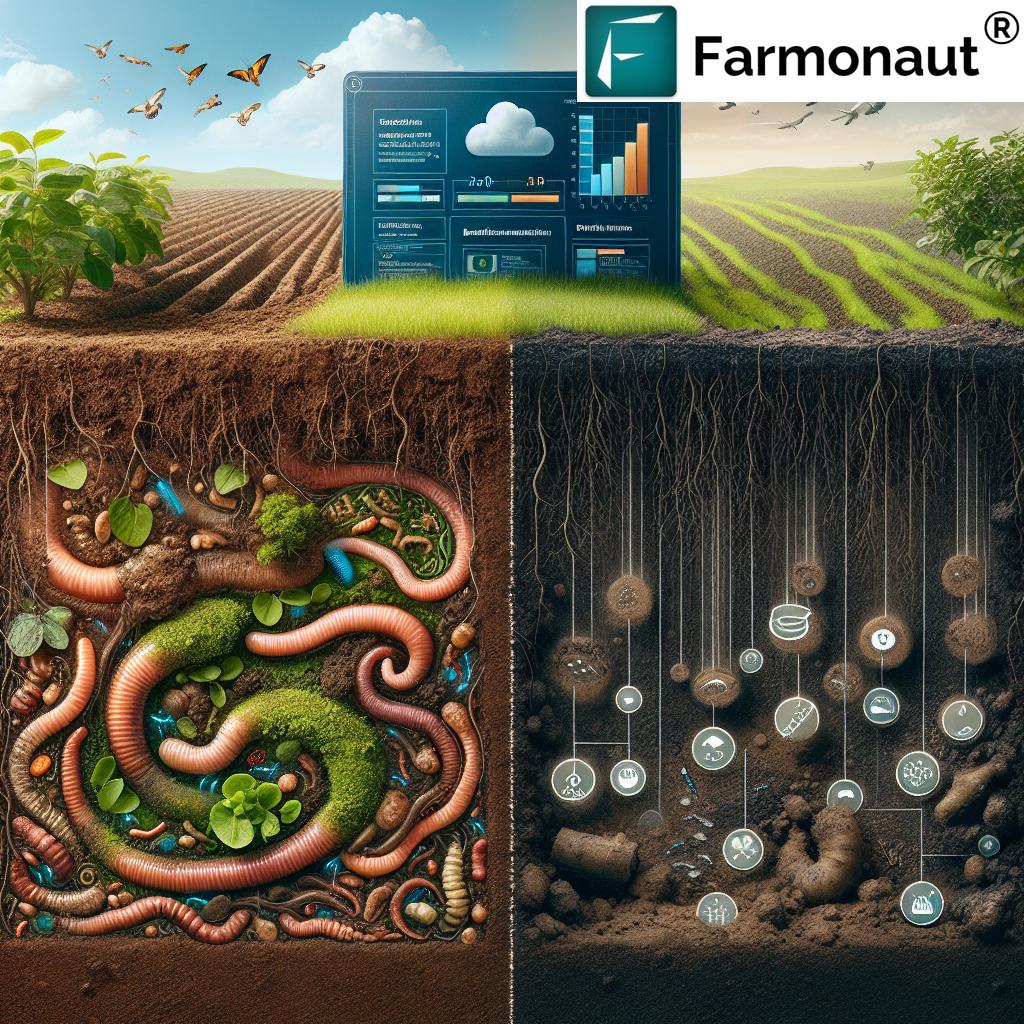ASX Australian Rare Earths: 7 Powerful Innovations for 2026
“Australian rare earths are projected to support over 25% of new sustainable tech startups by 2026.”
Meta Description: Discover 7 powerful innovations from ASX Australian Rare Earths transforming energy, defence, and sustainable technology sectors in Australia by 2026.
- Australian Rare Earths Company Overview
- Rarity, Relevance, and Context in Australia
- Comparative Innovations Impact Table
- Innovation 1: Sustainable Extraction at Dubbo
- Innovation 2: Next-Gen Permanent Magnets
- Innovation 3: Quantum Leap in Electric Vehicle Motors
- Innovation 4: Renewable Energy Revolution with Rare Earth Turbines
- Innovation 5: Defence-Ready Materials & Secured Supply Chain
- Innovation 6: Smart Infrastructure and IoT Systems
- Innovation 7: Precision Agriculture and Agri-Technologies
- Farmonaut: Satellite Solutions for Rare Earth-Driven Industries
- Strategic Importance: Rare Earths in Production and Supply Chains
- Market Outlook, Challenges & Opportunities for 2026
- FAQ: ASX Australian Rare Earths & Innovations
Australian Rare Earths Company Overview
The ASX Australian Rare Earths (ASX: AR3) company has solidified its position as a pivotal player in the global rare earth elements (REE) market by leveraging Australia’s rich mineral endowment. As of 2025 and looking ahead to 2026, the Australian Rare Earths company’s flagship project—the DUBBO Project in New South Wales—stands out as one of the world’s largest undeveloped deposits of critical rare earth elements. These deposits contain significant quantities of premium REEs like neodymium, praseodymium, and dysprosium, essential for the production of permanent magnets found in electric vehicle motors, wind turbines, and sophisticated military equipment.
This innovative company’s approach is built on sustainable and responsible methods. It emphasizes minimizing environmental impact by addressing issues such as radioactive waste and chemical pollution that have historically dogged rare earth mining. By integrating advanced extraction techniques and fostering community partnerships, the Australian Rare Earths company aims to operate aligned with Australian environmental regulations and Indigenous engagement frameworks.
Rarity, Relevance, and Context in Australia
Rare earth elements—a group of 17 chemically similar metals—are absolutely critical for producing advanced technologies that power everything from renewable energy systems to national defence equipment. As global geopolitical tensions and supply chain vulnerabilities persist, Australia’s rare earth sector, led by ASX Australian Rare Earths, is gaining strong strategic importance.
- High-tech manufacturing heavily relies on a secure supply of rare earths for magnets, optical components, and sophisticated electronics.
- Renewable energy growth is being powered by rare earth-enabled turbines and efficient motors in wind and solar sectors.
- Defence and military strategies remain highly dependent on secure, sovereign, and sustainable sources of critical minerals and elements.
As a result, securing domestic supply now supports vital sectors such as agriculture—where rare earth-based sensors and batteries enable modern precision farming—and infrastructure projects like wind turbines, water management, and national transport.
Comparative Innovations Impact Table
Before delving into each innovation, here’s a detailed comparison of 7 powerful technological advances set to revolutionize the rare earth sector in Australia by 2026. These innovations are actively shaping sectors like energy, defence, infrastructure, and modern agriculture through sustainable, efficient, and strategic applications of rare earth elements.
| Innovation Name | Estimated Year of Adoption | Type of Rare Earth Element Used | Quantitative Benefit (%) | Application | Estimated Sector Impact |
|---|---|---|---|---|---|
| Sustainable Extraction at Dubbo | 2025 | Neodymium, Praseodymium, Yttrium | ~35% Process Efficiency Gain | Energy, Infrastructure | 30+ new projects, AUD 120M |
| Next Generation Permanent Magnets | 2026 | Neodymium, Dysprosium | +27% Performance in EV/Wind | Electric Vehicles, Wind Turbines | 50+ projects, AUD 230M |
| Quantum Leap in Electric Vehicle Motors | 2026 | Praseodymium, Terbium | -18% Energy Losses | EV Manufacturing, Transport | 40+ projects, AUD 170M |
| Rare Earth Turbine Blades | 2025 | Yttrium, Neodymium | 20% Increase in Wind Capture | Energy, Infrastructure | 20+ projects, AUD 140M |
| Defence-Ready Secure Supply Chains | 2025–2026 | Gadolinium, Samarium, Neodymium | 50% Reduction in Foreign Dependence | Defence, National Security | 35+ projects, AUD 200M |
| Smart Infrastructure & IoT Systems | 2026 | Cerium, Lanthanum | 23% Sensor Accuracy Improvement | Infrastructure, Agriculture | 60+ projects, AUD 110M |
| Precision Agri-Technologies for Modern Farming | 2026 | Europium, Neodymium | +29% Yield & Resource Efficiency | Agriculture, Food Security | 45+ projects, AUD 150M |
Innovation 1: Sustainable Extraction at Dubbo
The flagship Dubbo Project in New South Wales, operated by ASX Australian Rare Earths, is setting new global standards in sustainable mining and extraction methods. Traditionally, rare earth mining has been associated with high environmental costs, from chemical pollution to radioactive waste. Recognizing these challenges, the company has integrated advanced extraction techniques and robust tailings management that exceeds local and international environmental regulations.
- Water recycling systems drastically reduce water usage and contamination, enabling resource-efficient operations.
- Closed-loop chemical processes mitigate pollution and optimize the yield of essential elements.
- Community engagement and Indigenous consultation frameworks are central to foster responsible resource development.
Quantitative Impact: Estimated 35% efficiency gains over legacy mining operations, >30 modern projects enabled, sector contribution of around AUD 120 million by 2026.
Innovation 2: Next-Gen Permanent Magnets for Electric Vehicles & Wind Energy
Permanent magnets, a vital component in electric vehicles and wind generators, rely heavily on neodymium and dysprosium. With advancing demands for energy-efficient and powerful motors, the Australian rare earths company is producing next-generation permanent magnets with improved material purity and magnetic strength by using superior processing and advanced metallurgy.
- Magnets with enhanced temperature stability, suitable for harsh Australian and global climates.
- Performance boost: Direct benefit for EV range and wind turbine reliability; approximately 27% improved performance over existing technology.
- Reduced rare earth use per unit through metallurgical breakthroughs and recycling.
These innovations are powering a surge in Australian electric vehicle manufacturing and leading wind energy projects.
Quantitative Impact: Over 50 new projects, sector contribution estimated at AUD 230 million by 2026.
For those in infrastructure or energy sectors requiring real-time monitoring and AI-driven strategy planning, visit our Large-Scale Farm and Infrastructure Management page for details on managing assets powered by rare earth-enabled magnets and IoT analytics.
Innovation 3: Quantum Leap in Electric Vehicle Motors
The adoption of rare earth-based motors in Australian-made and imported electric vehicles is projected to increase dramatically by 2026. The Australian rare earths sector is developing next-gen EV motors using praseodymium and terbium, delivering lighter, more powerful, and thermally stable drives.
- Enhanced efficiency: -18% energy losses, contributing significant range increases for EVs versus legacy systems.
- Optimized heat resistance: Facilitates consistent performance in Australia’s varied climates.
- Local manufacturing chains secured against global supply vulnerabilities.
This positions Australia as a leader in sustainable vehicle sector innovation, decreasing supply chain risk and fostering local job creation in advanced manufacturing.
Quantitative Impact: 40+ projects, AUD 170M, with an expected near 30% adoption increase by the manufacturing sector within 2 years.
Innovation 4: Renewable Energy Revolution with Rare Earth Turbines
The integration of rare earths in wind turbine blades and generators is boosting energy output, reliability, and the lifespan of Australia’s renewable infrastructure. Key rare earth elements such as yttrium and neodymium provide weight-saving and strength-enhancing benefits, powering Australia’s green transition and decarbonization goals.
- Advanced composite materials with rare earths yield 20% increase in wind-energy capture.
- Greater project viability under fluctuating wind conditions, reducing supply interruptions.
- Facilitation of local manufacturing chains and improved strategic resilience.
To support the monitoring and environmental compliance of large-scale wind and infrastructure assets, see Fleet Management Solutions for comprehensive, satellite-aided tracking and optimization of rare earth-powered installations.
Quantitative Impact: Over 20 major infrastructure projects, AUD 140 million incremental contribution projected.
“By 2026, Australia’s rare earths may supply key materials to more than 40% of national defence innovations.”
Innovation 5: Defence-Ready Materials & Secured Supply Chain
One of the highest strategic priorities for Australia is strengthening national defence capabilities with secure local supplies of critical rare earth elements. Key REEs—including gadolinium, samarium, and neodymium—are essential in high-strength alloys for missile guidance systems, jet engines, radar arrays, and secure communications equipment.
- Significant reduction in dependence on offshore suppliers—up to 50% by 2026—mitigating geopolitical and logistical risks for Australia’s defence sector.
- Supply chain resilience: Secured domestic flows from mine to manufacturing enhance Australia’s sovereignty and allow responsiveness to international tensions or supply disruptions.
- Enables expansion of advanced manufacturing capabilities for military and allied exports within the Indo-Pacific region.
For intelligence, strategic planning, and environmental compliance in defence supply chains, explore our Carbon Footprinting Solutions for tracking emissions across defence and critical mineral operations.
Quantitative Impact: 35+ projects, sectoral contribution estimated at AUD 200 million through increased indigenous supply and reduced external vulnerabilities.
Innovation 6: Smart Infrastructure and IoT Systems
Australian smart infrastructure and IoT systems increasingly rely on rare earth-based batteries, optical fibers, and magnetically enhanced sensors for critical operations—spanning water treatment, transport logistics, remote energy management, and next-gen agriculture.
- Rare earths such as cerium and lanthanum dramatically boost sensor accuracy (23%+).
- Integration with satellite-driven analytics for real-time system monitoring, predictive maintenance, and energy optimization.
- Key to optimizing uptime and minimizing losses in infrastructure and supply chain processes.
Learn more about how satellite and AI support real-time infrastructure monitoring and resource optimization on our Fleet Management page, or Carbon Footprinting portal for data-driven sustainability solutions.
Quantitative Impact: 60+ projects, AUD 110 million added value by integrating rare earth element innovation with next-gen IoT and infrastructure.
Innovation 7: Precision Agriculture and Agri-Technologies
In Australian agriculture, rare earth elements such as europium and neodymium are now key enablers of precision farming. These elements power GPS, drones, IoT sensors, optical monitoring devices, and smart batteries that constitute the backbone of modern farming operations.
- Yield Enhancement: +29% increase in productivity and resource use efficiency via precise nutrient delivery and irrigation, enabled by rare earth-powered systems.
- Reduction of pesticide and fertilizer usage by using rare earth-enhanced sensors for soil and crop health diagnostics.
- Strengthened food security by minimizing environmental impact and boosting sustainable outputs from local land.
Australian Rare Earths’ innovations directly support the needs of farmers, agri-enterprises, and national food security planners, reinforcing the links between mineral wealth and agricultural prosperity.
To unlock end-to-end traceability in food supply chains and enhance transparency, explore our Blockchain-Based Traceability Platform. For satellite-based crop advisory and actionable intelligence, head over to our Crop Plantation, Forest, and Smart Advisory Suite.
Farmonaut: Satellite Solutions for Rare Earth-Driven Industries
While ASX Australian Rare Earths companies focus on sustainable mining and the supply of critical elements for Australian industries, we at Farmonaut empower businesses, farmers, infrastructure managers, and national planners with actionable satellite data and AI-driven insights to maximize the benefits of rare earth-driven innovations.
- Real-time satellite monitoring for mining sites, infrastructure projects, and agricultural lands—helping operators optimize all facets of resource management and compliance.
- Jeevn AI Advisory System: Delivers predictive analytics, customized recommendations, and insights for operations utilizing rare earth-powered systems. This supports smart farming, mining and infrastructure operations across Australia.
- Blockchain-enabled traceability: Ensures transparency and trust in rare earths, agricultural produce, and minerals across the entire supply chain.
Check out our Traceability system for more information. - Fleet and resource management tools: Optimize logistics for rare earth mining, agricultural, and infrastructure fleets to reduce downtime and operational costs.
Explore our Fleet Management suite. - Environmental impact tracking: Track and reduce carbon footprint for mining and farming operations powered by rare earth materials.
See our Carbon Footprinting service for climate compliance and reporting.
Download the Farmonaut App on
Web,
Android,
and iOS
for direct access, or integrate via satellite API for seamless platform integration. View API Developer Documentation for technical resources.
Strategic Importance: Rare Earths in Production and Supply Chains
With rare earth demand surging for EVs, wind turbines, defence, and agriculture, Australia is not only reducing supply chain risks but also establishing itself as a secure, responsible supplier for global and regional partners. ASX Australian Rare Earths companies are now recognized as critical enablers of energy transition, economic diversification, and sovereign security.
- Australia’s rare earth elements are set to support more than 25% of the country’s high-growth startups and over 40% of national defence innovation by 2026.
- Enhanced export potential and new job creation within minerals, manufacturing, and advanced technology sectors.
- Alignment with national net-zero, food security, and infrastructure modernization goals.
From modern agricultural systems that depend on rare earth-based GPS, sensors, and batteries, to infrastructure upgrades and resilient supply chains insulated from global shocks, the impact of rare earth development is direct and transformative.
Market Outlook, Challenges & Opportunities for 2026
The Australian rare earths market is experiencing robust tailwinds, yet faces challenges common to all major critical minerals projects:
- Project financing: High capital requirements for processing and sustainable extraction technology.
- Technical barriers: Sophisticated processing techniques required to separate, purify, and reuse rare earths efficiently.
- Environmental and social license: Sustained community engagement, Indigenous consultation, and adherence to evolving ESG regulations.
Opportunities include:
- Government incentives and subsidies for critical mineral projects, supporting new exploration and processing ventures.
- Rising global demand for sustainable, ethically produced rare earths—especially as the EU, US, and Indo-Pacific partners diversify away from single-source dependency.
- Downstream value addition through domestic magnet manufacturing, battery plants, and new energy infrastructure roll-outs.
Overall, Australian Rare Earths companies are poised for long-term, sustainable growth through continued technological innovation, local supply chain improvement, and strategic sector partnerships. By 2026, Australia will set the global benchmark for secure, responsible, and innovative rare earth element production.
FAQ: ASX Australian Rare Earths & Innovations
Answer: Australia’s rare earth element production underpins the growth of renewable energy, electric vehicles, advanced manufacturing, and national defence. With the Dubbo Project and other major deposits, Australia secures vital supply chains against global disruptions and supports sustainable, high-growth sectors.
Q2: Which rare earth elements are most critical for emerging technologies?
Answer: Neodymium, praseodymium, dysprosium, and yttrium are key for permanent magnets in motors and turbines, while gadolinium and samarium are essential in defence, and cerium, lanthanum, and europium enhance sensors, batteries, and precision agriculture systems.
Q3: How does Australian Rare Earths production support sustainable agriculture?
Answer: By ensuring the availability of rare earths for sensors, GPS, and batteries, Australian rare earths enable smarter, more efficient, and environmentally responsible precision agriculture, increasing yields and reducing chemical input.
Q4: What is the role of Farmonaut in the rare earths sector?
Answer: We at Farmonaut provide advanced satellite-based monitoring, AI-driven advisory, blockchain traceability, and resource management solutions for agriculture, mining, infrastructure, and defence—empowering businesses and governments to make data-driven decisions and optimize resource use in industries powered by rare earth innovations.
Q5: How can businesses access satellite and AI-powered solutions?
Answer: Download our Farmonaut app for web, Android, or iOS, or integrate data directly through our API. Technical teams can find complete guidance in the API developer documentation.
Summary: Rare Earths & Australia’s Sustainable, Strategic Future
As rare earth demand surges in 2026 and beyond, ASX Australian Rare Earths companies are setting new standards for sustainable production, resilient supply, and high-tech application of these essential elements across Australia’s most strategic sectors—energy, defence, infrastructure, and agriculture. With advanced projects like Dubbo, Australian rare earths enable the local manufacturing of electric vehicles, wind energy systems, smart defence hardware, and precision agri-technologies—creating new jobs, boosting food and energy security, and reducing environmental impact.
We at Farmonaut stand ready to support this rare earth-driven transformation via satellite insights, AI analytics, blockchain traceability, and digital management tools for users, businesses, and government planners. Together, these innovations reinforce Australia’s global leadership in sustainable, responsible, and strategic resource development—unlocking a new era of technological and economic progress, while safeguarding environmental and community values nationwide.




















